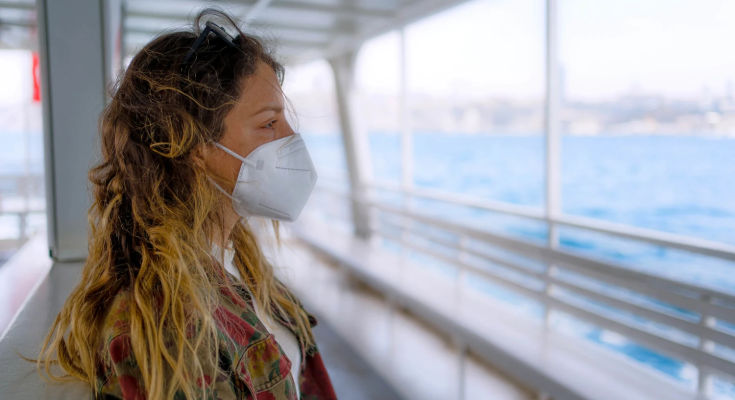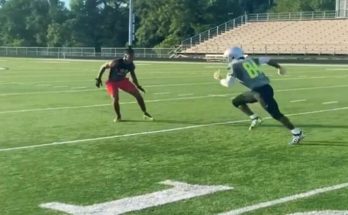What is the new LB.1 variant and is it causing a summer COVID-19 wave? Experts discuss symptoms, vaccines, isolation guidelines, and more.
As COVID-19 cases continue to rise across the United States, scientists are monitoring the spread of a new variant called LB.1. The highly contagious omicron subvariant, along with the fast-growing FLiRT strains, appear to be contributing to an anticipated summer wave, according to experts.
In recent weeks, the country has seen surges in test positivity and emergency room visits. As millions of people travel for summer vacation and gather indoors to seek refuge from heat waves, cases are expected to keep rising.
Currently, LB.1 is the third-leading COVID-19 variant nationwide, trailing close behind the FLiRT strains, including the dominant KP.3.1.1 and KP.3 variants, according to the U.S. Centers for Disease Control and Prevention.
LB.1 is a spinoff of JN.1 with additional mutations that set it apart from previous strains. Since the end of May, the share of cases caused by LB.1 has doubled, per CDC data.
While hospitalizations and deaths are still relatively low compared to waves earlier in the pandemic, it’s clear that the SARS-CoV-2 virus is spreading rapidly and making a lot of people sick.
President Joe Biden, U.S. Health & Human Services Secretary Xavier Beccera and more than 40 athletes at the Paris Olympics tested positive for COVID-19 in the last month, among others.
How bad is this year’s summer wave? Are the new variants causing different symptoms? What should you do if you get sick? Here’s what we know about the current COVID-19 trends in the U.S. and the new LB.1 strain so far.
Is there a summer surge?
In recent weeks, cases have been on the rise in nearly all regions of the country. The CDC estimates that as of July 30, COVID-19 cases are growing or likely growing in 32 states, stable or uncertain in eight states, and declining in three states.
Test positivity was at 17.6% during the week ending Aug. 3, per the CDC, up from about 15% the previous two weeks. For context, this past winter’s peak was 12%. A CDC map shows that test positivity rates are highest in the Southern region.
Viral activity in wastewater is “very high” nationally, with 44 states reporting “very high” or “high” levels individually. (The CDC no longer tracks the total number of new COVID-19 cases in the U.S.)
What’s more, COVID-related emergency room visits were up 4% in the past week and hospitalizations are rising, per the CDC.
There are clear indicators that a summer COVID-19 wave is underway — but it’s still too early to tell how trends will unfold, Andrew Pekosz, Ph.D., virologist at Johns Hopkins University, tells TODAY.com.
“When I look at the U.S. map of test positivity, I see a lot of variability in rates,” says Pekosz, adding that reduced reporting of COVID-19 cases has made it harder to see how quickly trends are changing.
According to Dr. William Schaffner, professor of infectious diseases at Vanderbilt University Medical Center, the recent spike in cases was expected. “There isn’t a part of the country right now that’s unaffected by this,” says Schaffner. COVID-19 has caused waves in previous summers, but these tend to be less severe than winter surges, he adds.
COVID-19 hospitalizations remain relatively low compared to last winter but have increased “very substantially” in the last two weeks, Schaffner notes.
As summer travel peaks and people increasingly gather indoors in the air conditioning amid ongoing heat waves, COVID-19 is expected to keep rising.
“There are plenty of opportunities for this virus to spread from person to person right now, and when that happens, the virus will find people who are at higher risk of severe disease, and that accounts for the increase in hospitalizations that we’re seeing,” Schaffner adds.
What is LB.1?
LB.1 is part of the omicron family — the newest great grandchild, so to speak, says Schaffner. The LB.1 subvariant is a direct offshoot of JN.1, which was dominant for most of the winter and spring.
“LB.1 is closely related to the FLiRT variants, but it has a couple of unique mutations in different parts of the spike protein,” says Pekosz. These include key mutations that affect LB.1’s ability to evade immunity.
“We’ve seen mutations like this before with other variants (including JN.1). … They don’t seem to be particularly concerning or a sign that the virus has changed drastically,” Pekosz adds.
The emergence of LB.1 continues an ongoing trend, the experts note. The SARS-CoV-2 virus mutates and gives rise to new variants, which are better able to escape immunity and outcompete other strains until a new one emerges.
More than 97% of people in the U.S. have natural or vaccine-induced antibodies against COVID-19, but this fades over time, per the CDC.
Is LB.1 more transmissible?
A characteristic of omicron subvariants is that they are very transmissible. “LB.1 highly contagious, and it is spreading very readily,” says Schaffner.
How does LB.1 compare to other new strains? “It’s too soon to tell, but so far, there is no signal that it is more transmissible than the FLiRT variants,” Dr. Bernard Camins, medical director of infection prevention at Mount Sinai Health System, tells TODAY.com.
“It may be more likely to escape immunity gained from infection or the vaccine, but it hasn’t shown that it’s more dangerous than previous subvariants,” says Camins.
The recent increase in cases appears to be driven by a combination of new variants, including LB.1 and the FLiRT strains. However, decreases genomic surveillance and sequencing make it challenging to accurately track the virus. “It’s becoming harder for us to get a good sense of how quickly a variant is increasing,” says Pekosz.
What are the symptoms of LB.1?
LB.1 does not seem to be causing any distinct or new symptoms and there is no indication that it produces more severe disease, the experts emphasize.
The symptoms of LB.1 are very similar to those caused by the FLiRT variants, which include:
- Sore throat
- Cough
- Fatigue
- Congestion
- Runny nose
- Fever or chills
- Headache
- Muscle aches
- New loss of sense of taste or smell
- Nausea or vomiting
- Diarrhea
The newer strains appear to be producing generally milder infections compared to previous years, says Schaffner. But COVID can still cause a spectrum of illness.
“Some people have a very classic sore throat, runny nose, cough and low-grade fever,” Dr. Paul Sax, the clinical director of the division of infectious diseases at Brigham and Women’s Hospital and a professor of medicine at Harvard Medical School, told NBC News. “In others, it’s mostly nausea and diarrhea with very minimal respiratory symptoms. It can vary from A to Z and beyond.”
And “some people can still experience severe symptoms, enough to hospitalize them,” Camins tells TODAY.com — namely, high risk groups: people age 65 and older, people with underlying medical conditions, and individuals who are immunocompromised.
“Now, there’s no one symptom where you say, ‘Hey, you probably have COVID,’” Dr. Steven Furr, a family physician in Jackson, Alabama, and president of the American Academy of Family Physicians, told NBC News. “Without a test, we’re not going to know for sure.”
Antivirals such as Paxlovid are effective against LB.1 and other recent strains, Schaffner notes.
Do vaccines protect against LB.1?
“The current vaccine will offer protection against severe disease,” says Schaffner. Right now, the updated 2023–2024 COVID-19 booster targeting the XXB.1.5 strain is still available. The CDC recommends high-risk groups get an additional dose.
The updated 2024–2025 vaccine to be released this fall is also expected to offer protection, the experts emphasize. “LB.1 is closely related to KP.2, which looks like it’ll be the strain targeted in the vaccine for this coming fall season,” says Pekosz.
“Previous data show that even if the vaccine doesn’t exactly match what’s circulating, there is cross-reactivity that gives you some protection,” says Camins.
The experts encourage everyone who is eligible to get an updated 2024–2025 COVID-19 vaccine this fall.
COVID guidelines 2024
If you develop COVID-19 symptoms or have an exposure, get tested, the experts emphasize. Testing is an important tool to protect yourself and prevent the spread of the virus.
PCR and antigen tests will detect LB.1 and other new variants, Camins notes. If you use an antigen test, follow FDA recommendations to avoid a false negative result.
The CDC recommends people who test positive stay home while sick and avoid contact with others. The agency used to recommend isolating from others for at least five days after testing positive. But in March 2024, its isolation guidelines changed to say people can return to normal activities after they have been fever-free without medication and symptoms have been improving for at least 24 hours.
“If you’re in a high-risk group and you test positive for COVID-19, we would give you Paxlovid to prevent severe illness,” says Schaffner.
How to protect against LB.1 variant
As COVID-19 cases keep rising this summer, consider taking additional steps to protect yourself and others. The CDC recommends people:
- Stay up to date with COVID-19 vaccines.
- Wear a mask in crowded, indoor spaces.
- Practice good hand hygiene.
- Cover coughs and sneezes.
- Improve ventilation.
- Practice social distancing.



